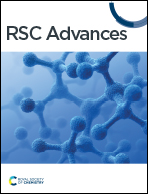Design of N–N ylide bond-based high energy density materials: a theoretical survey†
Abstract
The generally encountered contradiction between large energy content and stability poses great difficulty in designing nitrogen-rich high-energy-density materials. Although N–N ylide bonds have been classified as the fourth type of homonuclear N–N bonds (besides >N–N<, –N![[double bond, length as m-dash]](https://www.rsc.org/images/entities/char_e001.gif) N–, and N
N–, and N![[triple bond, length as m-dash]](https://www.rsc.org/images/entities/char_e002.gif) N), accessible energetic molecules with N–N ylide bonds have rarely been explored. In this study, 225 molecules with six types of novel structures containing N–N ylide bonds were designed using density functional theory and CBS-QB3 methods. To guide future synthesis, the effects of substitution on the thermal stability, detonation velocity, and detonation pressure of the structures were evaluated under the premise that the N–N ylide skeleton remains stable. The calculations show that the bond dissociation energy values of the N–N ylide bonds of the designed 225 structures were in the range of 61.21–437.52 kJ mol−1, except for N-1NNH2. Many of the designed structures with N–N ylide bonds exhibit high detonation properties, which are superior to those of traditional energetic compounds. This study convincingly demonstrates the feasibility of the design strategy of introducing an N–N ylide bond to develop new types of energetic materials.
N), accessible energetic molecules with N–N ylide bonds have rarely been explored. In this study, 225 molecules with six types of novel structures containing N–N ylide bonds were designed using density functional theory and CBS-QB3 methods. To guide future synthesis, the effects of substitution on the thermal stability, detonation velocity, and detonation pressure of the structures were evaluated under the premise that the N–N ylide skeleton remains stable. The calculations show that the bond dissociation energy values of the N–N ylide bonds of the designed 225 structures were in the range of 61.21–437.52 kJ mol−1, except for N-1NNH2. Many of the designed structures with N–N ylide bonds exhibit high detonation properties, which are superior to those of traditional energetic compounds. This study convincingly demonstrates the feasibility of the design strategy of introducing an N–N ylide bond to develop new types of energetic materials.



 Please wait while we load your content...
Please wait while we load your content...